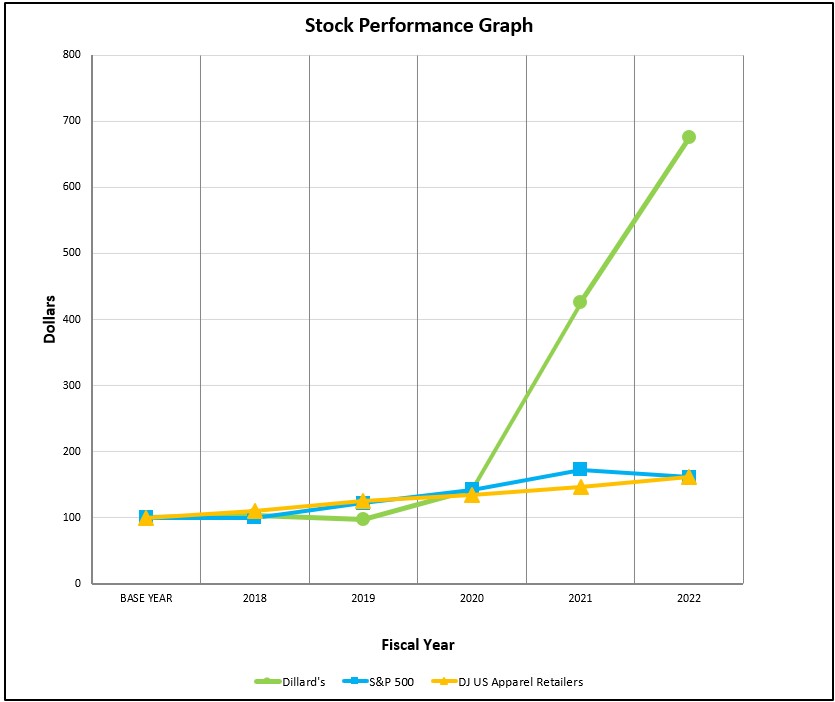We have made a significant investment in our trademark and license portfolio, in terms of design function, advertising, quality control and quick response to market trends in a quality manufacturing environment. Dillard’s trademark registrations are maintained for as long as Dillard’s holds the exclusive right to use the trademarks on the listed products.
Our merchandising, sales promotion and store operating support functions are conducted primarily at our corporate headquarters. Our back office sales support functions, such as accounting, product development, store planning and information technology, are also centralized.
We have developed a knowledge of each of our trade areas and customer bases for our stores. This knowledge is enhanced through regular store visits by senior management and merchandising personnel and through the use of online merchandise information and is supported by our regional merchandising offices. We will continue to use existing technology and research to edit merchandise assortments by store to meet the specific preference, taste and size requirements of each local operating area.
Wells Fargo Bank, N.A. (“Wells Fargo”) owns and manages Dillard’s private label credit cards, including credit cards co-branded with American Express (collectively “private label cards”) under a long-term marketing and servicing alliance (“Wells Fargo Alliance”). Under the Wells Fargo Alliance, Wells Fargo establishes and owns private label card accounts for our customers, retains the benefits and risks associated with the ownership of the accounts, provides key customer service functions, including new account openings, transaction authorization, billing adjustments and customer inquiries, receives the finance charge income and incurs the bad debts associated with those accounts. Pursuant to the Wells Fargo Alliance, we receive on-going cash compensation from Wells Fargo based upon the portfolio’s earnings. The compensation received from the portfolio is determined monthly and has no recourse provisions. We participate in the marketing of the private label cards, which includes the cost of customer reward programs. The Wells Fargo Alliance expires in November 2024.
We seek to expand the number and use of the private label cards by, among other things, providing incentives to sales associates to open new credit accounts, which generally can be opened while a customer is visiting one of our stores or online. Customers who open accounts are rewarded with discounts on future purchases. Private label card customers are sometimes offered private shopping nights, special discounts and advance notice of sale events. Wells Fargo administers the loyalty program that rewards customers for private label card usage.
Our earnings depend to a significant extent on the results of operations for the last quarter of our fiscal year. Due to holiday buying patterns, sales for that period average approximately one-third of annual sales. Additionally, working capital requirements fluctuate during the year, increasing during the second half of the year in anticipation of the holiday season.
We purchase merchandise from many sources and do not believe that we are dependent on any one supplier. We have no long-term purchase commitments or arrangements with any of our suppliers, but we consider our relationships to be strong and mutually beneficial.
Our fiscal year ends on the Saturday nearest January 31 of each year. Fiscal 2022, 2021 and 2020 ended on January 28, 2023, January 29, 2022 and January 30, 2021, respectively, and contained 52 weeks each.
Human Capital
As of December 24, 2022, the Company employed approximately 29,900 associates. Approximately 19,600 were full-time (greater than 35 hours per week) associates, 8,200 were part-time (20-35 hours per week) associates and 2,100 were limited status associates (less than 20 hours per week).1 None of our associates are represented by a union.
As a department store chain, the Company employs a wide range of associates, including sales associates, management professionals, maintenance professionals, call center associates, distribution center associates, buyers,
1 For purposes of this section, all figures are based on calendar year 2022.
